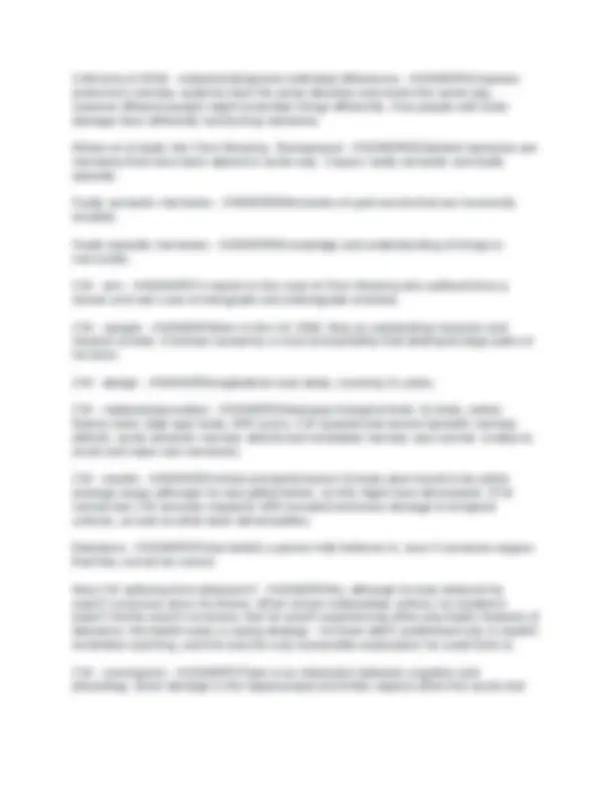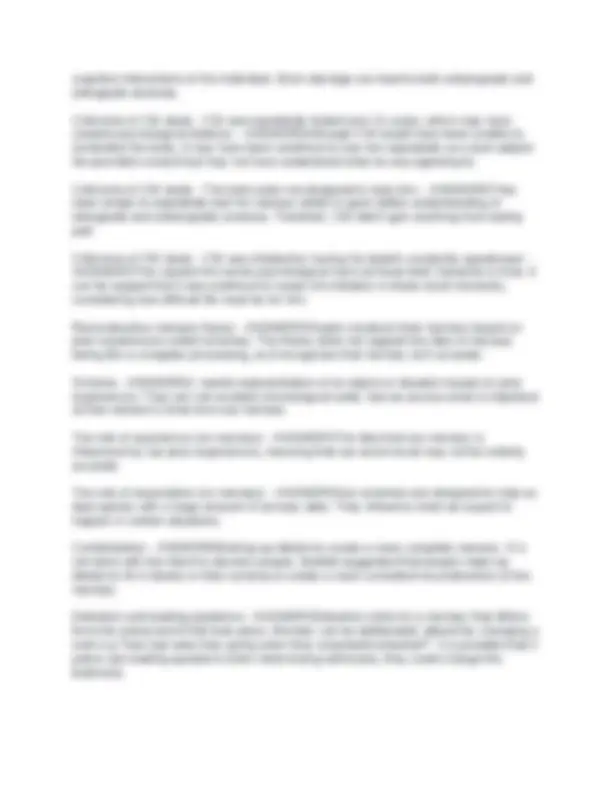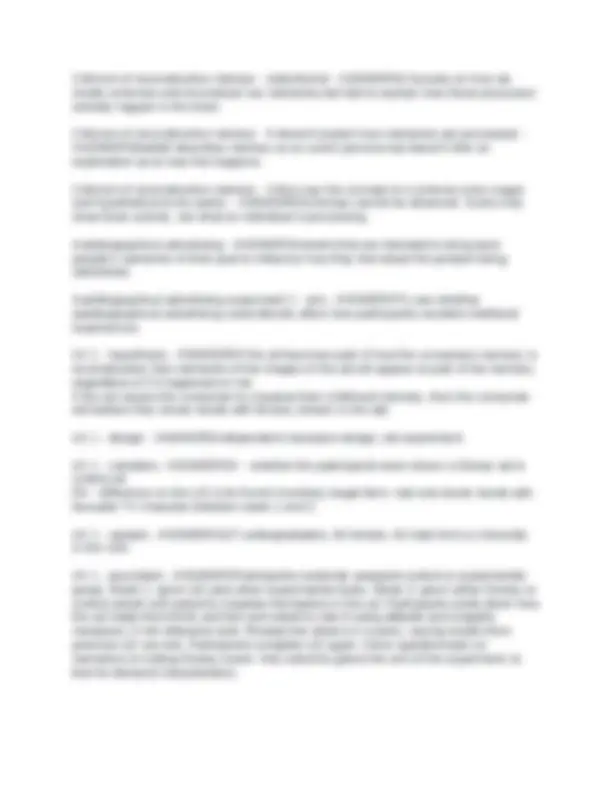





Study with the several resources on Docsity

Earn points by helping other students or get them with a premium plan


Prepare for your exams
Study with the several resources on Docsity

Earn points to download
Earn points by helping other students or get them with a premium plan
Community
Ask the community for help and clear up your study doubts
Discover the best universities in your country according to Docsity users
Free resources
Download our free guides on studying techniques, anxiety management strategies, and thesis advice from Docsity tutors
A comprehensive overview of human memory, exploring various models and theories. it delves into the multi-store model (msm), highlighting its components (sensory store, short-term memory, long-term memory), encoding processes, and limitations. the document also examines the role of the hippocampus, cerebellum, and frontal lobe in memory formation and retrieval, illustrating these concepts with case studies like clive wearing's amnesia. furthermore, it discusses reconstructive memory theory, schemas, and the impact of leading questions on memory accuracy, concluding with an analysis of autobiographical advertising and its influence on memory recall. This resource is valuable for students seeking a detailed understanding of memory mechanisms and their implications.
Typology: Exams
1 / 7

This page cannot be seen from the preview
Don't miss anything!




Input - ANSWERSInfo enters the memory through the senses Encoding - ANSWERSInfo is transformed into a format we can understand Storage - ANSWERSInfo is kept to use at a later time Retrieval - ANSWERSAbility to recall info from storage Output - ANSWERSInfo is used in some way Role of hippocampus - ANSWERSNew memories must pass through hippocampus before entering long-term storage. Important for creating semantic and biographical memories. Anterograde amnesia - ANSWERSThe inability to make new memories. Retrograde amnesia - ANSWERSThe inability to recall memories from the past. Hippocampus - anterograde amnesia - ANSWERSAnterograde amnesia usually caused by damage to the hippocampus, a vital element in the formulation of new memories. Info from STM is unable to pass through hippocampus to LTM. Frontal lobe - retrograde amnesia - ANSWERSDamage to frontal lobe can result in retrograde amnesia. Research suggests there is a relationship between retrograde amnesia and the frontal lobe in Alzheimer's patients. Remote memory tests were performed on participants and the results showed a significant correlation. Cerebellum - procedural memory - ANSWERSProcedural memory = motor skills. Stored in LTM. Damage to cerebellum can stop us learning new skills or developing new ones. Cerebellum also helps time and coordinate complex movements. Episodic memory - ANSWERSMemories of places, events and people.
Semantic memory - ANSWERSGeneral knowledge (facts, ideas, meaning, concepts). Procedural memory - ANSWERSResponsible for motor skills, so knowing how to do things like walking, feeding yourself etc. MSM - sensory store - ANSWERSencoding - input (5 senses) capacity - limited duration - 1-7 seconds forgetting - dacay MSM - short term memory - ANSWERSencoding - mostly acoustically, info that is paid attention to capacity - limited (average of 7 items) duration - up to 30 seconds forgetting - displacement or decay MSM - long term memory - ANSWERSencoding - mainly semantic capacity - unlimited duration - 1 second to forever forgetting - decay/retrieval failure Displacement - ANSWERSCapacity of STM is 7, so it can only hold a limited number of items. Therefore, when it is full, new info displaces old info, which will be forgotten if it has not been rehearsed. Decay - ANSWERSDecay happens when we do not pay attention to the sensory information. Therefore the information breaks down and is no longer available. Cues - ANSWERSThings that trigger your memory. State-dependent forgetting - ANSWERSOccurs in the absence of relevant psychological or physiological cues that were present during learning; they act as internal cues. Context-dependent forgetting - ANSWERSOccurs if relevant environmental cues that were present when learning the info are missing at recall; they act as external cues. Criticism of MSM - too simple - ANSWERSSuggests STM is a single store but research suggests that it is more complex than that and can deal with multiple sensory informations at one time. Criticisms of MSM - too much importance placed on the role of rehearsal versus meaning - ANSWERSSuggests that in order for info to be passed into the LTM, it must be rehearsed. However not all info is rehearsed, eg if something is shocking. We also don't tend to rehearse sensory info eg smell and taste.
cognitive interactions of the individual. Brain damage can lead to both anterograde and retrograde amnesia. Criticisms of CW study - CW was repeatedly tested over 21 years, which may have caused psychological distress. - ANSWERSAlthough CW would have been unable to remember the tests, it may have been unethical to use him repeatedly as a test subject. He provided consent but may not have understood what he was agreeing to. Criticisms of CW study - The tests were not designed to help him. - ANSWERSThey were simply to repeatedly test his memory ability to grain better understanding of retrograde and anterograde amnesia. Therefore, CW didn't gain anything from taking part. Criticisms of CW study - CW was irritated by having his beliefs constantly questioned. - ANSWERSThis caused him some psychological harm at those brief moments in time. It can be argued that it was unethical to cause him irritation in these short moments, considering how difficult life must be for him. Reconstructive memory theory - ANSWERSPeople construct their memory based on prior experiences called schemas. The theory does not support the idea of memory being like a computer processing, as it recognises that memory isn't accurate. Schema - ANSWERSA mental representation of an object or situation based on prior experiences. They are not recalled chronological order, but we access what is important at that moment in time from our memory. The role of experience (on memory) - ANSWERSThe idea that our memory is influenced by our prior experiences, meaning that our event recall may not be entirely accurate. The role of expectation (on memory) - ANSWERSOur schemas are designed to help us deal quickly with a huge amount of sensory data. They influence what we expect to happen in certain situations. Confabulation - ANSWERSMaking up details to create a more complete memory. It is not done with the intent to deceive people. Bartlett suggested that people make up details to fill in blanks in their schema to create a more consistent reconstruction of the memory. Distortion and leading questions - ANSWERSDistortion refers to a memory that differs from the actual event that took place. Memory can be deliberately altered by changing a verb e.g "how fast were they going when they smashed/contacted?". It is possible that if police use leading questions when interviewing witnesses, they could change the testimony.
Criticism of reconstructive memory - reductionist - ANSWERSIt focuses on how we create schemas and reconstruct our memories but fails to explain how these processes actually happen in the brain. Criticism of reconstructive memory - It doesn't explain how memories are processed. - ANSWERSBartlett describes memory as an active process but doesn't offer an explanation as to how this happens. Criticism of reconstructive memory - Critics say the concept of a schema is too vague and hypothetical to be useful. - ANSWERSSchemas cannot be observed. Scans only show brain activity, not what an individual is processing. Autobiographical advertising - ANSWERSAdverts that are intended to bring back people's memories of their past to influence how they feel about the product being advertised. Autobiographical advertising experiment 1 - aim - ANSWERSTo see whether autobiographical advertising could directly affect how participants recalled childhood experiences. AA 1 - hypothesis - ANSWERSIf the ad becomes part of how the consumers memory is reconstructed, then elements of the images of the ad will appear as part of the memory, regardless of if it happened or not. If the ad causes the consumer to visualise their childhood memory, then the consumer will believe they shook hands with Mickey (shown in the ad). AA 1 - design - ANSWERSIndependent measures design, lab experiment. AA 1 - variables - ANSWERSIV - whether the participants were shown a Disney ad or control ad. DV - difference on the LEI (Life Event Inventory) target item: met and shook hands with favourite TV character between week 1 and 2. AA 1 - sample - ANSWERS107 undergraduates, 64 female, 43 male from a University in the USA. AA 1 - procedure - ANSWERSParticipants randomly assigned control or experimental group. Week 1: given LEI plus other experimental tasks. Week 2: given either Disney or control advert and asked to visualise themselves in the ad. Participants wrote down how the ad made them think and feel and asked to rate it using attitude and empathy measures. 5 min distractor task. Researcher returns in a panic, saying results from previous LEI are lost. Participants complete LEI again. Given questionnaire on memories of visiting Disney resort. Also asked to guess the aim of the experiment, to test for demand characteristics.
Repetition - ANSWERSUsed to keep the brand at the forefront of consumer's minds and increases chances of it entering LTM and prevents decay. Can lead to brand familiarity, but also consumer fatigue, so balance in important. Consumers can feel negative about unfamiliar products, and there is evidence that they see repetition as a sign of quality. Cues - ANSWERSCues create a certain context or feeling when advertising products. When the consumer is then in the same situation or emotional state that is show in the advert, the advert will act as a cue to trigger the memory of the product. Avoiding overload - ANSWERSOverload is the result of too much info entering a memory store. The capacity of the STM is 7. So incoming info that exceeds this capacity is displaced. Autobiographical adveritising - ANSWERSLinks positive memories to the advertised product and makes consumers more likely to buy it. Often targeted at baby boomer generation. Positive memories are linked to the product. Wechsler memory scale - ANSWERSA diagnostic tool used by psychologists to evaluate how much brain damage patients have after injury or illness. Can be used on people aged 16-90. It has 7 different subtypes and results are presented in 5 sets looking at different aspects of memory: auditory, visual, visual working, immediate and delayed memory.